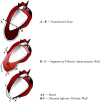Surgical ventricular restoration to reverse left ventricular remodeling
- PMID: 21286274
- PMCID: PMC2845790
- DOI: 10.2174/157340310790231626
Surgical ventricular restoration to reverse left ventricular remodeling
Abstract
Heart failure is one of the major health care issues in the Western world. An increasing number of patients are affected, leading to a high rate of hospitalization and high costs. Even with administration of the best available medical treatment, mortality remains high. The increase in left ventricular volume after a myocardial infarction is a component of the remodeling process. Surgical Ventricular Restoration (SVR) has been introduced as an optional therapeutic strategy to reduce left ventricular volume and restore heart geometry. So far, it has been established that SVR improves cardiac function, clinical status, and survival in patients with ischemic, dilated cardiomyopathy and heart failure. Since its first description , SVR has been refined in an effort to standardize the procedure and to optimize the results. This review will discuss the rationale behind surgical reversal of LV remodeling, the SVR technique, its impact on cardiac function and survival, and future expectations.
Keywords: Diastolic function.; Left ventricular remodeling; Myocardial infarction; Surgical ventricular restoration; Systolic function.
Figures



References
-
- McMurray JJ, Pfeffer MA. Heart failure. Lancet. 2005;365:1877–89. - PubMed
-
- Nohira A, Lewis E, Stevenson LW. Medical management of advanced heart failure. JAMA. 2002;287:628–40. - PubMed
-
- Jessup M, Brozena S. Heart failure. N Engl J Med. 2003;348:2007–18. - PubMed
-
- Copeland JG, McCarthy M. University of arizona, cardiac transplantation: changing patterns in selection and outcomes. Clin Transpl. 2001:203–7. - PubMed
-
- Deuse T, Haddad F, Pham M, et al. Twenty-year survivors of heart transplantation at stanford university. Am J Transplant. 2008;8:1769–74. - PubMed
LinkOut - more resources
Full Text Sources

